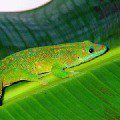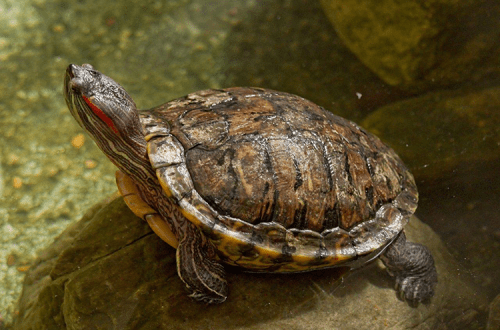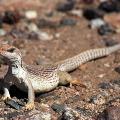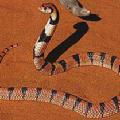
Scutellum cobra
Although the shield snake is called the cobra, it does not have such a pronounced hood as, for example, the king cobra. However, it has another distinguishing feature – an enlarged intermaxillary shield, which protrudes noticeably on the head, as if cut off in front and widening behind. Thanks to him, the snake received the species name of the shield cobra. In the genus of these cobras, there are only two species – ordinary and South African. Like all asps, shield cobras are venomous, however, their venom is not as toxic as that of other cobras, however, deaths from the bite of these snakes are known.
The shield cobra owes the unusual structure of its head to a burrowing lifestyle. Hiding in various substrates, it resembles a small bulldozer, as it pushes loose substance with its head. Also, the shield cobra is known as the African coral snake. Like all coral asps, it is brightly colored. And this coloring signals “careful, poison! “. When observing a cobra in a terrarium, it was noted that the shield snake is an incredibly intelligent and easily trained animal. In the wild, she is not too aggressive and prefers to hide from people, besides having not the best eyesight. In size, shield cobras never grow more than a meter in length.
Contents
Classification
Kingdom: Animals
Type: Chord
Class: Reptiles
Order: Scaly
Suborder: Snakes
Family: Aspidae
Genus: Shield cobras
Species: Common Shield Cobra (Aspidelaps scutatus), South African Shield Cobra (Aspidelaps lubricus)
Appearance
 The appearance of the shield cobra is quite remarkable. This snake is about a meter long, with a relatively thick body of orange, yellowish or pinkish color, decorated with black transverse stripes in the amount of 20 to 50 pieces, tapering towards the tail. In the region of the head, the color becomes more red, and the same black stripes are located around the head – in the area of uXNUMXbuXNUMXbthe eyes and neck. The belly of the snake is lighter, yellowish. So the appearance of the shield cobra can be called contrasting and noticeable against the background of natural colors. Especially bright young individuals. Extremely rare are white representatives of the species with black stripes – they are called albinos. And of course, a huge intermaxillary shield immediately stands out. The poisonous teeth of the shield cobra, like those of other cobras, are located closer to the anterior edge of the upper jaw and are equipped with a venom-conducting canal, resembling a hollow tube inside. These fangs are motionless and slightly bent back – a characteristic feature of all aspids.
The appearance of the shield cobra is quite remarkable. This snake is about a meter long, with a relatively thick body of orange, yellowish or pinkish color, decorated with black transverse stripes in the amount of 20 to 50 pieces, tapering towards the tail. In the region of the head, the color becomes more red, and the same black stripes are located around the head – in the area of uXNUMXbuXNUMXbthe eyes and neck. The belly of the snake is lighter, yellowish. So the appearance of the shield cobra can be called contrasting and noticeable against the background of natural colors. Especially bright young individuals. Extremely rare are white representatives of the species with black stripes – they are called albinos. And of course, a huge intermaxillary shield immediately stands out. The poisonous teeth of the shield cobra, like those of other cobras, are located closer to the anterior edge of the upper jaw and are equipped with a venom-conducting canal, resembling a hollow tube inside. These fangs are motionless and slightly bent back – a characteristic feature of all aspids.
Distribution and habitation
Both species of shield cobras are found in Africa. South African is typical for the southwestern regions of the mainland, in particular, the Cape Province and Namibia. It can also be found in countries such as South Africa, Botswana, Zimbabwe, Angola, Lesotho, and in the east – in Mozambique and Swaziland.
The common shield cobra lives in Botswana, a landlocked country, as well as in the northeast of the Republic of South Africa, in Mozambique and in the area between the Zambezi and Limpopo rivers.
The preferred biotope for both types of cobras is dry rocky or grassy areas, as well as semi-deserts. The snake selects for life places where it can dig shelters for itself. The South African cobra sometimes prefers to live in trees. In general, vegetation for these snakes also sometimes acts as shelters. They climb rocks and stone rubble very well.
Behavior and lifestyle
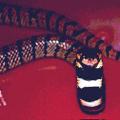 It is no coincidence that the shield cobra is considered a rare species, and not only in terms of numbers. She, indeed, extremely rarely reveals her presence, most of the time hiding in foliage or dense vegetation. This snake also prefers to hunt in dense woody thickets. Shield cobras are characterized by rapid growth and maturation compared to other snakes. They may be slightly more aggressive than other cobras, but they never attack without warning. Getting bitten by a shield cobra is more likely to happen by accident than by its malicious intent. People who watched these snakes in captivity noted such an amazing quality as vindictiveness. Indeed, shield cobras remember offenders for a long time and constantly show aggression towards them, for example, this is manifested in the relationship between a snake and a person who has caught it. At the same time, shield cobras are considered very intelligent snakes, and in many terrarium collections they are favorites. In captivity, shield cobras feel good, grow quickly, easily get used to food and are able to breed. Their venom is neurotoxic, however, these snakes are inferior to the genus of real cobras in their poisonousness. There is a version that it was the movement of African shield cobras that became the basis for the martial art of capoeira. So graceful and almost imperceptible is their final bite throw. In case of danger, shield cobras behave similarly to others – hiss threateningly and inflate a small hood. But they also have another amazing feature. These snakes are able to “feign death” by turning over on their back and freezing – such is its passive defense against attack. A similar technique in the world of reptiles is also used by the collared cobra.
It is no coincidence that the shield cobra is considered a rare species, and not only in terms of numbers. She, indeed, extremely rarely reveals her presence, most of the time hiding in foliage or dense vegetation. This snake also prefers to hunt in dense woody thickets. Shield cobras are characterized by rapid growth and maturation compared to other snakes. They may be slightly more aggressive than other cobras, but they never attack without warning. Getting bitten by a shield cobra is more likely to happen by accident than by its malicious intent. People who watched these snakes in captivity noted such an amazing quality as vindictiveness. Indeed, shield cobras remember offenders for a long time and constantly show aggression towards them, for example, this is manifested in the relationship between a snake and a person who has caught it. At the same time, shield cobras are considered very intelligent snakes, and in many terrarium collections they are favorites. In captivity, shield cobras feel good, grow quickly, easily get used to food and are able to breed. Their venom is neurotoxic, however, these snakes are inferior to the genus of real cobras in their poisonousness. There is a version that it was the movement of African shield cobras that became the basis for the martial art of capoeira. So graceful and almost imperceptible is their final bite throw. In case of danger, shield cobras behave similarly to others – hiss threateningly and inflate a small hood. But they also have another amazing feature. These snakes are able to “feign death” by turning over on their back and freezing – such is its passive defense against attack. A similar technique in the world of reptiles is also used by the collared cobra.
Food
 Like other snakes, shield cobras are carnivores. In the wild, their diet often consists of their smaller relatives and various reptiles. However, in the nursery, they surprisingly quickly switch to feeding on rodents and do not show any particular fastidiousness. However, rodents for such large snakes are often reared, specially fattened, since cobras need good food. All animals are recommended to snakes to be fed dead so that they do not accidentally injure cobras. Usually the snake swallows its prey whole, so it usually does not experience a lack of vitamins. The feeding regimen of an adult cobra is several times a week. But during the mating season, a pregnant female may need more frequent feeding. And sometimes pregnant snakes completely refuse to eat – this is normal, but keeping the female on a starvation diet, of course, is not worth it, because it is impossible to predict when she will start eating again in full force. Since shield cobras are prone to eating their own kind, it is still recommended to keep and feed them one by one. Giving seafood – fish and shellfish – is not worth it for shield cobras, this food is more suitable for water snakes.
Like other snakes, shield cobras are carnivores. In the wild, their diet often consists of their smaller relatives and various reptiles. However, in the nursery, they surprisingly quickly switch to feeding on rodents and do not show any particular fastidiousness. However, rodents for such large snakes are often reared, specially fattened, since cobras need good food. All animals are recommended to snakes to be fed dead so that they do not accidentally injure cobras. Usually the snake swallows its prey whole, so it usually does not experience a lack of vitamins. The feeding regimen of an adult cobra is several times a week. But during the mating season, a pregnant female may need more frequent feeding. And sometimes pregnant snakes completely refuse to eat – this is normal, but keeping the female on a starvation diet, of course, is not worth it, because it is impossible to predict when she will start eating again in full force. Since shield cobras are prone to eating their own kind, it is still recommended to keep and feed them one by one. Giving seafood – fish and shellfish – is not worth it for shield cobras, this food is more suitable for water snakes.
Reproduction
Information about the reproduction of shield cobras is extremely scarce. Some sources indicate that their mating season begins in the spring, it is then that mating takes place, and in the summer laying. These snakes, like other cobras, have “nuptial dances”: the male usually crawls around the female, touching her with his tongue and head and gradually wrapping himself around. The female, ready for laying, builds a nest by digging a hole in suitable soil, fallen leaves or other loose substrate. 10-13 small oval leathery eggs are laid there, which will lie in the nest for about 2-3 months. All this time, the mother cobra jealously guards the masonry, not letting anyone near it. Young growth is born already poisonous, about 5-18 cm in size. Young shield cobras are distinguished by a particularly bright outfit, which fades a little with age.
Sources of
http://ru.wikipedia.org
http://www.zmeuga.ru/
http://www.greglasley.net
http://www.kobri.narod.ru
http://www.creaturesandcritterscaptivebred.com



